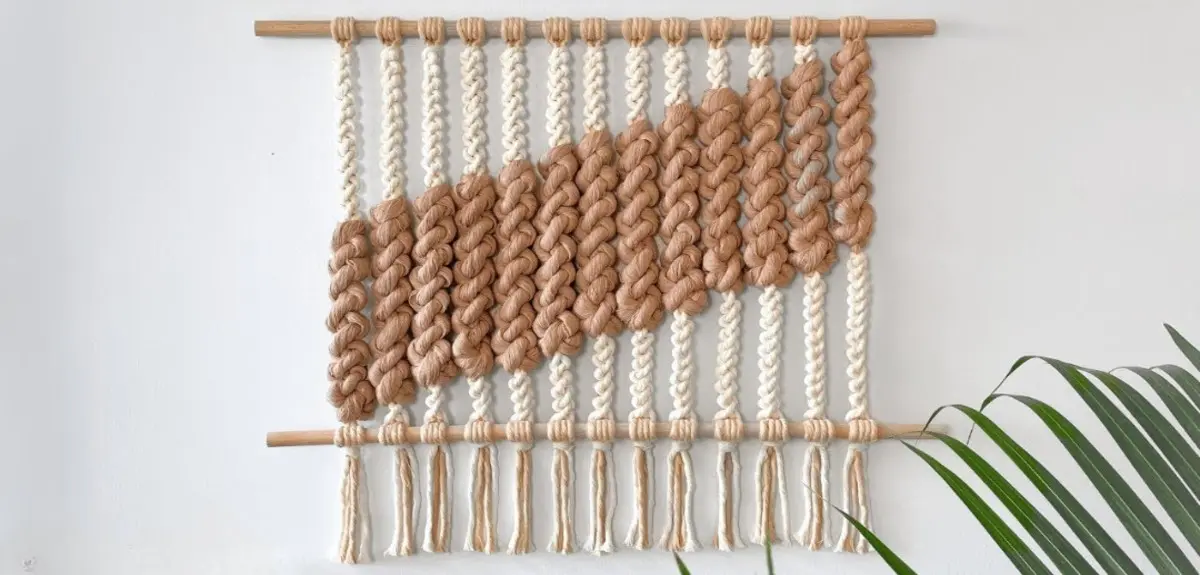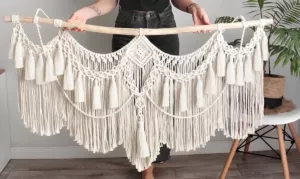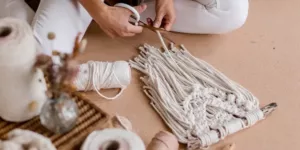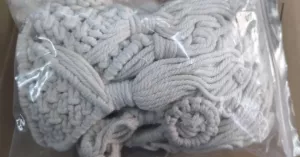Creating breathtaking macrame masterpieces requires more than basic knotting skills—it demands understanding how to expertly blend various cord weights for stunning visual impact. Combining different macrame cord thickness transforms ordinary projects into extraordinary statement pieces that captivate viewers and showcase your advanced crafting expertise.
Professional macrame artists worldwide recognize that combining different macrame cord thickness represents the pinnacle of design sophistication. This advanced technique separates amateur crafters from skilled artisans, creating depth, texture, and visual interest impossible to achieve with single-weight materials. Whether you’re designing architectural installations, intricate wall hangings, or functional home décor, mastering mixed-thickness techniques opens unlimited creative possibilities.
This comprehensive guide reveals insider secrets for combining different macrame cord thickness successfully, providing step-by-step strategies, troubleshooting solutions, and professional insights that will revolutionize your macrame artistry. Transform your projects from simple crafts into professional-quality pieces that command attention and admiration.
Understanding the Art of Combining Different Macrame Cord Thickness
The foundation of successfully combining different macrame cord thickness lies in understanding how various weights interact mechanically and visually within a single piece. Professional designers recognize that different thicknesses create natural hierarchy, drawing the eye through intentional pathways while establishing structural integrity and aesthetic balance.
When combining different macrame cord thickness, consider the mathematical relationships between weights. A 3:1 ratio (such as 9mm paired with 3mm cord) creates dramatic contrast, while closer ratios like 2:1 produce subtle gradations. These proportional relationships significantly impact the final appearance and structural behavior of your piece.
Material compatibility becomes crucial when combining different macrame cord thickness. Cotton blends beautifully with cotton, maintaining consistent stretch and aging characteristics. However, mixing natural fibers with synthetics requires careful consideration of how different materials respond to tension, humidity, and time. Professional macrame artists spend years understanding these material interactions.
The visual weight of different thicknesses affects perception dramatically. Thick cords naturally draw attention and provide grounding elements, while thin cords create delicate details and flowing transitions. Successfully combining different macrame cord thickness requires balancing these visual weights to create harmonious compositions that feel intentional rather than accidental.
Strategic Planning for Mixed Cord Thickness Projects
Professional success in combining different macrame cord thickness begins with comprehensive project planning. Start by sketching your design, identifying where each thickness will appear and how transitions between weights will occur. This planning phase prevents costly mistakes and ensures adequate material preparation.
Calculate cord requirements carefully when combining different macrame cord thickness. Thick cords consume length differently than thin ones, and mixed projects often require 20-30% more total material than single-thickness designs due to transition zones and experimental sections. Professional designers always purchase extra material for complex mixed-thickness projects.
Consider the working sequence when combining different macrame cord thickness. Generally, establish structural elements with thicker cords first, then add detail work with thinner materials. This approach prevents delicate elements from damage during heavy manipulation phases while ensuring proper tension distribution throughout the piece.
Timeline planning differs significantly for projects combining different macrame cord thickness. Mixed projects typically require 40-60% more time than single-thickness pieces due to complexity, material changes, and technique adjustments. Factor this additional time into project deadlines and client expectations.
Essential Techniques for Seamless Thickness Transitions
Mastering transitions represents the most challenging aspect of combining different macrame cord thickness. Professional techniques include graduated transitions, where intermediate thicknesses bridge gaps between extreme weights, creating smooth visual flows that feel natural and intentional.
The splice transition technique allows combining different macrame cord thickness mid-project without visible connection points. This advanced method involves unraveling cord ends, interweaving fibers, and carefully securing connections within existing knot structures. Practice this technique extensively before incorporating it into important projects.
Layering techniques provide another powerful method for combining different macrame cord thickness. By working different weights in separate layers that interact at specific points, you can create complex visual effects while maintaining structural integrity. This approach works particularly well for large wall hangings and architectural installations.
Anchor point management becomes critical when combining different macrame cord thickness. Different weights create varying tensions that can distort mounting systems or create uneven hanging behavior. Professional designers use distributed anchor systems and tension equalization techniques to manage these challenges effectively.
Design Principles for Multi-Thickness Compositions
Visual hierarchy forms the cornerstone of successful designs combining different macrame cord thickness. Use thick cords to establish primary focal points and structural elements, medium weights for secondary details and transitions, and thin cords for delicate accents and fine details. This hierarchy guides viewer attention naturally through your composition.
Proportion and scale relationships become amplified when combining different macrame cord thickness. Apply the golden ratio (1:1.618) to thickness relationships, spacing intervals, and overall composition dimensions. These mathematical relationships create inherently pleasing designs that feel balanced and professional.
Color coordination requires special consideration when combining different macrame cord thickness. Different weights often display color differently due to surface texture variations and light reflection properties. Test color combinations across all intended thicknesses before committing to large quantities of material.
Texture contrast intensifies dramatically when combining different macrame cord thickness. Thick cords create bold, architectural textures, while thin cords produce delicate, lace-like effects. Balance these contrasts to prevent overwhelming viewers while maintaining visual interest throughout the piece.
Advanced Knotting Adaptations for Mixed Thickness Work
Traditional macrame knots require significant modifications when combining different macrame cord thickness. Square knots, for example, need adjusted tension and potentially modified wrapping techniques to accommodate varying cord diameters while maintaining consistent appearance and structural integrity.
The compound knot technique specifically addresses challenges in combining different macrame cord thickness. This method involves creating knots that incorporate multiple cord weights simultaneously, distributing stress evenly while creating unique visual effects impossible with single-thickness techniques.
Transition knots serve as specialized connections when combining different macrame cord thickness. These modified knots disguise thickness changes while maintaining structural continuity. Professional macrame artists develop signature transition knots that become recognizable elements of their artistic style.
Tension management becomes exponentially more complex when combining different macrame cord thickness. Thick cords require firm pressure and confident manipulation, while thin cords need gentle handling to prevent breakage. Developing ambidextrous tension control takes extensive practice but remains essential for professional results.
Structural Engineering for Multi-Thickness Projects
Load distribution calculations become crucial when combining different macrame cord thickness in functional pieces like plant hangers or hammocks. Different weights bear loads differently, and failure to account for these variations can result in catastrophic project failure or safety hazards.
Mounting hardware selection must accommodate the complex forces generated when combining different macrame cord thickness. Standard hooks and mounting systems may prove inadequate for mixed-thickness pieces, requiring specialized hardware and installation techniques to ensure safety and longevity.
Stress concentration points appear wherever different thicknesses connect in your project. These areas require reinforcement techniques, load distribution strategies, and often protective elements to prevent premature wear or failure. Professional engineers often consult on large installations combining different macrame cord thickness.
Environmental considerations affect mixed-thickness projects differently than single-weight pieces. Different thicknesses respond uniquely to humidity, temperature changes, and UV exposure. Plan for differential expansion, color fading, and structural changes when combining different macrame cord thickness in varying environments.
Troubleshooting Common Multi-Thickness Challenges
Tension inconsistencies represent the most frequent problem when combining different macrame cord thickness. These issues manifest as puckering, uneven spacing, or distorted knot shapes. Professional solutions include tension equalization techniques, progressive tensioning methods, and specialized tools for maintaining consistent pressure across different weights.
Connection failures often occur at transition points when combining different macrame cord thickness. These failures result from inadequate connection techniques, mismatched materials, or improper stress distribution. Prevent failures through proper transition planning, reinforcement techniques, and regular inspection of connection points during construction.
Visual discontinuities can destroy the effectiveness of projects combining different macrame cord thickness. These problems arise from poor transition planning, inappropriate thickness ratios, or inadequate color coordination. Address discontinuities through careful design planning and progressive transition techniques.
Material compatibility issues emerge over time in projects combining different macrame cord thickness. Different materials age at different rates, creating visual and structural problems. Prevent compatibility issues through careful material selection, accelerated aging tests, and proper environmental controls.
Professional Finishing Techniques for Mixed Thickness Projects
Edge finishing becomes significantly more complex when combining different macrame cord thickness. Different weights create uneven edges that require specialized techniques to achieve clean, professional appearances. Professional finishers use graduated trimming, selective fringing, and weight-specific finishing methods.
Surface preparation for mixed-thickness projects involves techniques not required for single-weight pieces. Steam blocking, selective pressing, and tension equalization help create uniform surfaces despite varying cord weights. These preparation steps significantly impact final appearance quality.
Quality control inspection procedures must address the unique challenges of combining different macrame cord thickness. Professional quality systems check connection integrity, tension uniformity, visual continuity, and structural soundness through specialized inspection protocols.
Documentation and maintenance instructions become crucial for complex pieces combining different macrame cord thickness. Different weights require different care procedures, and mixed projects need comprehensive maintenance schedules to ensure longevity and appearance retention.
Creative Applications and Project Ideas
Architectural installations benefit tremendously from combining different macrame cord thickness. Room dividers, ceiling installations, and outdoor structures gain visual impact and structural integrity through strategic thickness variations. Professional architects increasingly specify mixed-thickness macrame for commercial and residential applications.
Functional furniture applications showcase the structural benefits of combining different macrame cord thickness. Chairs, tables, and storage solutions gain strength and durability while maintaining the organic appeal of macrame construction. These applications require engineering consideration but offer unique market opportunities.
Artistic wall hangings reach new levels of sophistication when combining different macrame cord thickness. Gallery-quality pieces use thickness variations to create depth, movement, and visual interest that captivates viewers and commands premium prices in the art market.
Fashion and accessory applications demonstrate the versatility of combining different macrame cord thickness. Jewelry, bags, and clothing elements benefit from the textural interest and structural properties available through mixed-thickness techniques.
Advanced Color Theory for Multi-Thickness Designs
Color interaction intensifies dramatically when combining different macrame cord thickness because varying weights display identical colors differently. Thick cords absorb light and appear darker, while thin cords reflect more light and seem brighter. Professional designers account for these optical effects during color selection.
Gradient effects become possible when combining different macrame cord thickness with coordinated color schemes. By pairing thick cords in deep tones with thin cords in light shades, you can create sophisticated ombré effects that showcase both color and texture transitions simultaneously.
Contrast management requires special attention when combining different macrame cord thickness. High contrast between both thickness and color can overwhelm viewers, while insufficient contrast creates bland, uninteresting results. Professional designers use test samples to achieve optimal contrast balance.
Lighting considerations affect mixed-thickness projects more than single-weight pieces. Different thicknesses cast varying shadows and reflect light differently, creating complex lighting interactions that can enhance or detract from the overall effect depending on installation conditions.
Tools and Equipment for Advanced Multi-Thickness Work
Specialized scissors and cutting tools become necessary when combining different macrame cord thickness. Standard scissors may struggle with thick cords while proving too aggressive for delicate materials. Professional macrame artists maintain multiple cutting tools optimized for different weight ranges.
Measuring and marking tools require adaptation for mixed-thickness projects. Standard measuring techniques may prove inadequate for the complex spacing requirements when combining different macrame cord thickness. Professional tools include adjustable spacing guides and thickness-compensated measuring devices.
Tensioning aids help maintain consistent pressure when combining different macrame cord thickness. These tools range from simple tension guides to sophisticated mechanical systems that automatically adjust pressure based on cord weight. Investment in quality tensioning aids significantly improves results.
Organization systems become crucial for managing multiple cord weights simultaneously. Professional workshops use weight-coded storage, color-coordinated organization, and systematic layout procedures to prevent confusion and maintain efficiency during complex multi-thickness projects.
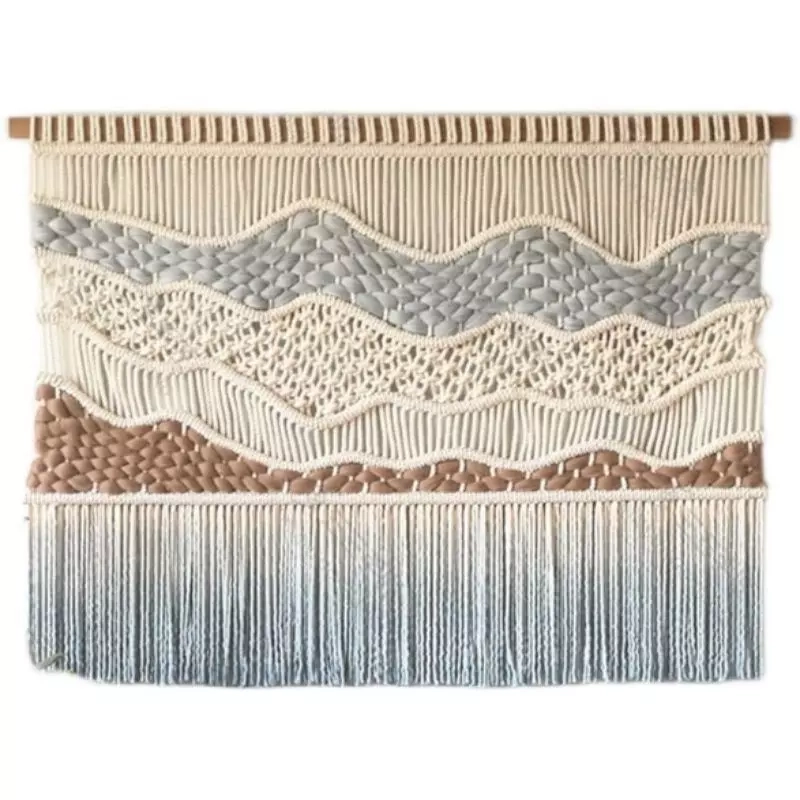
Large Nordic Bohemian for Macrame Wall Hanging
Elevate your home decor with the stunning Large Nordic Bohemian Macrame Wall Hanging, a perfect blend of Scandinavian minimalism and bohemian flair. This handwoven tapestry is an exquisite piece of art that adds warmth, texture, and style to any room, making it an ideal choice for those looking to create a cozy and chic atmosphere.
Frequently Asked Questions
What’s the optimal thickness ratio when first starting to experiment with combining different macrame cord thickness?
Begin with a 2:1 thickness ratio when learning to combine different macrame cord thickness. This ratio provides noticeable contrast without overwhelming complexity, making it ideal for developing transition techniques and understanding how different weights interact within single projects.
How do I prevent structural weakness at connection points when combining different macrame cord thickness?
Strengthen connection points by using reinforcement knots, distributing stress across multiple connection points, and selecting transition techniques appropriate for your specific thickness combinations. Always test connection strength before incorporating techniques into important projects combining different macrame cord thickness.
Can I successfully combine natural and synthetic materials when mixing cord thicknesses?
While possible, combining natural and synthetic materials when mixing thicknesses requires careful consideration of differential aging, stretch characteristics, and environmental responses. Professional results typically come from combining different macrame cord thickness within the same material family.
What’s the biggest mistake beginners make when starting to combine different cord thicknesses?
The most common error is attempting overly complex thickness combinations without mastering basic transition techniques. Start with simple two-thickness projects, perfect your transition methods, then gradually increase complexity as your skills develop in combining different macrame cord thickness.
Conclusion
Mastering the art of combining different macrame cord thickness transforms your crafting from basic hobby to professional artistry. This advanced technique requires patience, practice, and systematic skill development, but the results speak for themselves—creating sophisticated pieces that showcase your expertise and command attention in any setting.
The journey toward expertly combining different macrame cord thickness involves understanding material properties, developing specialized techniques, and applying professional design principles. By following the strategies outlined in this guide and practicing consistently, you’ll develop the skills necessary to create stunning mixed-thickness pieces that elevate your macrame artistry to professional levels and open new creative possibilities for your future projects.

